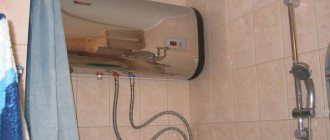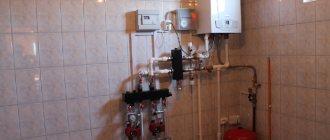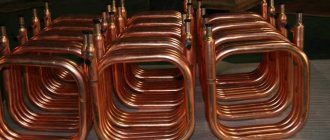All yours with you - storage water heater
A storage water heater is also called a water heater. It is a well-insulated tank in which a fuel element is installed. When turned on, it heats up the entire volume to the set temperature, after which it maintains it.
Storage boilers differ in power and volume. The more power, the faster it will heat the water. The larger the volume, the longer it will take to bring it to the desired temperature.
There are boilers with closed (dry) and open (wet) heating elements. Dry, or closed-type heating element, is in the flask and does not come into contact with water. The space in the flask can be filled with air, oil or sand. In storage water heaters with wet heating elements, the heating element comes into contact with water and heats it directly.
Features of instantaneous water heaters
The instantaneous water heater provides fast heating of tap water at the moment of switching on. Its hydraulic part cuts directly into the water supply line. Heating of water in flow-through models is provided by one or several heating elements of increased power. The presence of several heating elements makes it possible not only to increase the outlet temperature, but also to smoothly regulate the heating. Another type of heating elements used in instantaneous electric water heaters is an uninsulated coil, placed in a heat-resistant PTFE sheath.
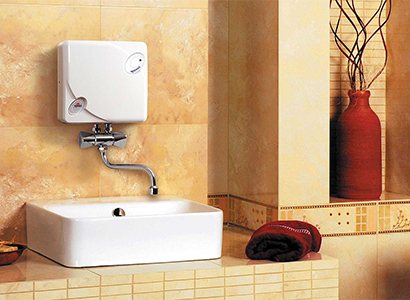
Unlike storage devices, there is no tank in flow-through water heaters. The device turns on when the tap is opened and turns off immediately after it is closed. Running water, passing through the water heater, immediately heats up to the set temperature and flows out of the tap while it is already warm.
In expensive instantaneous water heaters with advanced functionality, complex automation is used that regulates the heating intensity depending on the water flow rate and its temperature at the inlet. This adjustment is done by changing the number of heating elements involved and the total power of the appliance. In budget models, there is no such precise adjustment, and the heating elements operate with a fixed power.
Instantaneous water heaters are divided into gravity and pressure. Models of the first type deliver water at atmospheric pressure and are designed for one point of water intake. Often, flow-through non-pressure devices are immediately equipped with a tap or shower head connected directly to the body of the device. Pressure water heaters deliver running water with only a small loss of head, relative to the water supply pressure. Due to this, it is possible to provide hot water supply to several points of water intake at once. However, pressure devices are characterized by increased power consumption, the value of which can reach 6-20 kW.
The performance of the flow-through device depends on the type of heating elements used. When using heating elements, water flows through a brass or copper heat exchanger and does not come into contact with the heater, which excludes the formation of scale on it. However, with this design, the efficiency of heating the liquid is reduced.
An open spiral gives more intense heating of water in a flow-through device. But the capacity of water heaters of this design is 10-15% higher, which increases energy consumption. Another problem with these devices is the formation of scale, since the heating element is in contact with running water.The designs of modern models are developed so that when the liquid passes through the device, vibrations are created that prevent scale settling, but such a system does not provide one hundred percent efficiency. Therefore, to protect against limescale, an open coil instantaneous water heater is recommended to be installed after a filter that reduces water hardness. Also, the device requires periodic cleaning.
All flow-through water heaters are equipped with sensors and safety devices that stop operation if the input pressure is insufficient or the water temperature is too high.
Advantages of instantaneous water heaters:
- Instant heating of water up to 35-60 ° C.
- There is no need for preheating and depending on the volume of the tank, as in storage boilers.
- Compactness. The device is small in size and can be easily hidden under the sink.
- Low price compared to storage heaters.
At the same time, flow-through units also have disadvantages. When buying them, you need to take into account the high power, which usually exceeds 2 kW. This places an increased stress on the electrical wiring. It is recommended to run a separate line to connect an instantaneous heater, and in old buildings this is a mandatory requirement. Pressure electric water heaters are connected only to a 380 V network. The disadvantages of flow models include the dependence on the pressure and inlet temperature of the water.
Water-storage water heater (indirect heating)
Such water heaters are not flow-through, they are produced only in the form of boilers. They are heated not by electricity or gas, but by heat from water or a heat carrier from another system.
The following can be used as a heat source:
- Central heating system;
- Gas boiler circuit;
- Water heated in a solid fuel boiler;
- Heat carrier for solar collectors.
You can read more in the article "Indirect heating boiler: what is it?".
Types of boilers that exist today
The main types according to the method of heating water:
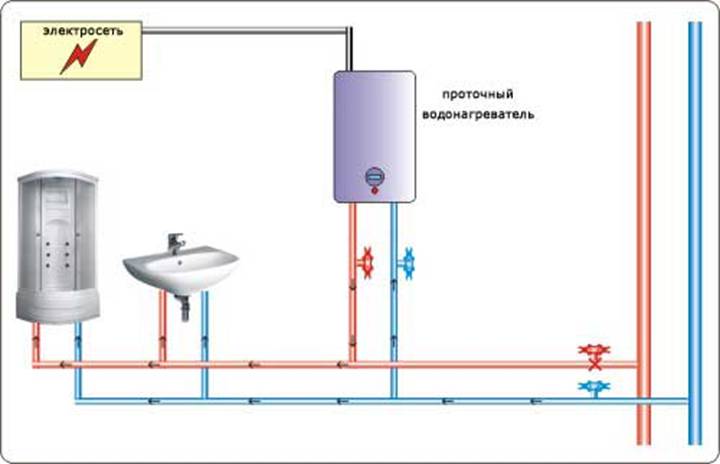

Installation diagram of an instantaneous water heater.
- electrical;
- gas: with an open combustion chamber (using natural draft); with a closed combustion chamber (using forced draft);
- indirect heating (those that use the power of the boiler);
- combined - using gas and electricity.
By the way of water supply:
- pressure head;
- non-pressure (can be used in the absence of water supply).
By installation method:
- floor;
- suspended (subdivided into vertical and horizontal).
By the shape of the tank:
- round (in the form of a cylinder);
- oval (in the form of an oval rectangle);
- other forms.
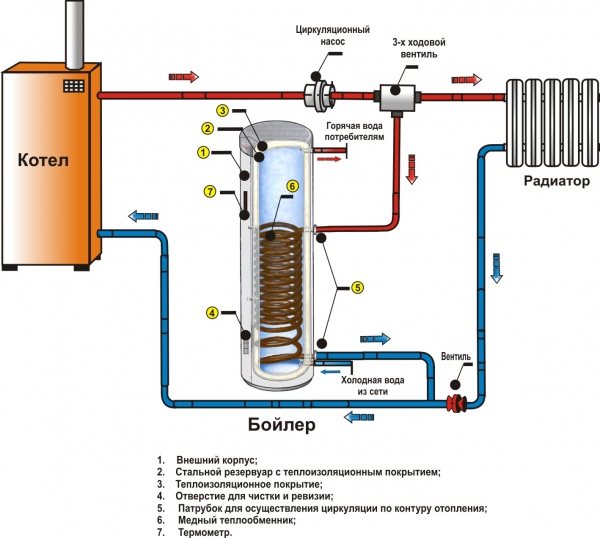

Diagram of an indirect heating boiler.
An electric boiler consists of a metal tank, a heating element (thermal electric heater), a magnesium anode and a thermostat. The magnesium anode serves to protect against corrosion inside the tank. The outside surface of the tank is covered with a layer of heat-insulating material. Additional items may be present depending on the model.
Principle of operation: The heating element, placed inside the tank, heats the water. Cold water is supplied from below, hot water is output from above. The pressure in the water supply system pushes the heated water, and it enters the points of use. The thermostat controls the water temperature (the user sets this parameter himself, changing it if necessary), heating the water to the set value and maintaining the temperature by turning the heating element on and off.
Related article: Analog mode in a domestic incubator
The advantages of an electric water heater are: lower cost, ease of installation, no need for a chimney, the ability to install in any convenient place, even under the ceiling (suspended horizontal boilers are designed just for this).
The electric boiler is connected to the household power supply, so it is convenient to use it in the house, in the apartment, in the country, in small businesses for household purposes.
Gas boiler. The principle of operation is the same as that of an electric one, only the water is heated from a gas burner.
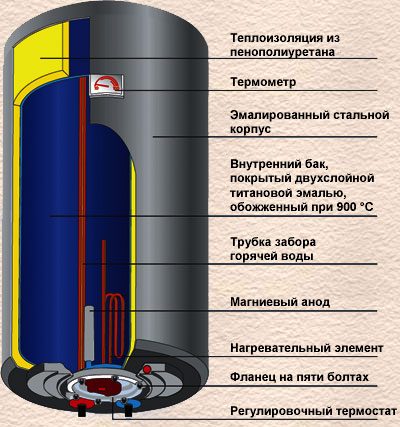

Wiring diagram for connecting the boiler.
To install it, you need to make an additional outlet into the chimney, and this complicates the installation and affects the location of the device. A boiler with a closed combustion chamber (using forced draft) can be installed against an external wall with the exhaust of combustion products through a special hole in it.
Advantages: with a higher purchase and installation cost, a gas boiler is cheaper during operation, since the price of gas is much lower than that of electricity. Another advantage is high power compared to electric. This allows you to quickly heat the water to the desired temperature, so a slightly smaller boiler can be purchased for the same needs. Disadvantages: arbitrary placement is impossible, additional documentation is needed for installation, and the main one - gas is not available everywhere.
Indirect heating boiler. Can be used in addition to a single-circuit boiler. The cylinder-shaped container can be installed vertically or horizontally depending on the model. A heat exchanger tube is placed inside the container, which has a complex shape (usually serpentine). A coolant circulates through this pipe, which heats the water.
There are models without heat exchanger tubes. Such a boiler consists of two vessels inserted one into the other. Heated water is in the inner vessel, and the heat carrier circulates in the outer one.
Principle of operation: cold water enters the boiler tank through the inlet, in the coil of the heat exchanger or between the double walls of the casing circulates a heat-transfer fluid heated by the heating boiler. It heats up the incoming water in the boiler and maintains it at a constant temperature. Each indirect heating boiler has inlet and outlet pipes connecting it to the heating boiler, and hot water is supplied to the consumer through the outlet pipe.
Related article: How and how to insulate a house from aerated concrete outside
Advantages:
- high performance;
- the heat transfer fluid is specially prepared, thereby reducing its negative impact on the heat exchanger;
- you can use various sources of thermal energy, as well as switch from one to another if necessary (there are models of boilers with built-in heating elements).
Disadvantages:
- high cost of equipment and installation (you need to invite specialists);
- when heating a large volume of water, less heat is supplied for heating;
- installation must be carried out in a special room (boiler room).
Which water heater is more profitable, instantaneous or storage?
The issue of saving is important, especially in a large family. According to the norms for calculating hot water supply, the average consumption per person is 50 liters of hot water per day. This corresponds to 75-90 liters of warm water with a temperature of 35-40 ° C.
Hot water supply (DHW) (eng. Heat water supply) - provision of household needs of the population and production needs in water with an increased (up to 75 ° C) temperature. It is one of the indicators of the quality of life, an important factor in improving the sanitary and hygienic and cultural and living conditions of life.
Wikipedia
It is believed that an instantaneous water heater consumes more than a boiler. Although some believe the opposite. So who's right? In fact, this is not entirely true.Let's take a closer look at the issue.
Flowing or storage: pros and cons
Any equipment has positive and negative sides. This also applies to water heaters. We'll cover them in this section.
Instantaneous water heaters
Pros:
- Small size and weight;
- Can be equipped with a mixer or shower;
- Hot water is supplied immediately.
Minuses:
- For electrical ones, you need to lay reinforced wiring;
- There is no supply of water in case of a shutdown;
- Large resource consumption when turned on.
Features:
To install an electric instantaneous water heater, you need to lay a separate cable or change the wiring. Its power consumption is in the range of 2.5-6.5 kW / h. It depends on the flow rate, water pressure and inlet and outlet temperatures.
Important!
In multi-storey buildings, the wiring is designed for no more than 5 kW. Many models of hot water flowers have a high maximum power. If the power consumption is exceeded, the automatic machine at the entrance to the apartment may turn off.
Gas or electric water heater
In this matter, everything is pretty simple. The days of gas installations are over. This is not the safest equipment and also requires compliance with established standards. For example, there is SNiP 42-01-2002 (it was adopted instead of 2.04.08-87), which talks about gas distribution systems, there is a point where it says that gas appliances are not recommended to be installed in some rooms. For example, in bathrooms less than 6 m2. Also, a chimney must be present in the room, since the columns are not connected to the hood. There are many other requirements as well.
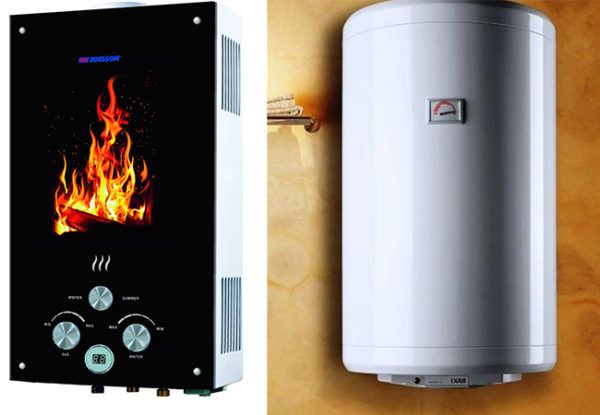

Electric water heaters are more modern systems that are much easier to operate and maintain. However, there are many such models. Before deciding on the main characteristics of boilers, it is worth deciding which type of equipment is better.
Which water heater is better, instantaneous or storage - summing up
As you can see, instantaneous and storage water heaters differ greatly in their characteristics. So which one should you choose?
If you have a gas connection and are willing to pay for equipment and installation, it is best to install a gas fired water heater. So you will save on its subsequent operation. the cost of heat from gas is much lower than heat from electricity.
In apartment buildings, water shutdowns are not uncommon due to system breakdowns or preventive maintenance. A storage boiler will help solve this problem. In the event of a shutdown, you can drain the water from the boiler and use it for domestic needs.





